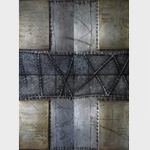Sergey Sergeyev “Urban archeology”
 On June, 18, 2009 a personal exhibition of a famous Saint Petersburg artist Sergey Sergeev opens in gallery D137. After a three year break the audience will be able to see new works created in distinctive author’s technique (paintings, paintings on metal).
On June, 18, 2009 a personal exhibition of a famous Saint Petersburg artist Sergey Sergeev opens in gallery D137. After a three year break the audience will be able to see new works created in distinctive author’s technique (paintings, paintings on metal).
Alexander Borovsky about Sergey Sergeev:
“Sergey Sergeev is an elusive artist; he is difficult to establish a “final diagnosis”. From the one hand, everything is clear: he has developed a reputation as a perfectionist, a subtle artist, and a master of craft: implementation, workability, and completeness. As the saying goes, you take it in your hands, and you hold a work. In this instance, the work takes a lot of time, taste, and workmanship. This is why you are secured from exhaustiveness and expendability: Sergeev’s work will conform to an interior – it will become rooted with new tones, edges, and nuances.
Well, quite a respectable niche especially taking into account professional approximation of our “sophisticated” sector of art-production. But on the other hand…This is what’s symptomatic: it seems that, before you know, Sergeev’s works somehow strive to abandon this niche of “interior perfectionism”. They withdraw into themselves, crawl away, and desire some different environment. Which? In this context, recent works created in metal: steel, etched dash – are especially illustrative. It is clear where they strive to crawl: to spans of American bridges, to paved roads with old forged manholes. What about others? Some crawl away to Paleolithic caves, others to Epichristian catacombs, and some draw closer to contemporary urban environment (a wall, dappled with graffiti). The work is constantly searching, striving to fumble its environment. That’s why it is not content with a niche: be it an interior or any other kind… And indeed, how can we talk about a niche, when a cursor is moving along such sharp amplitude: from Old Stone Age to modern urbanistics? I am more familiar with Sergeev’s recent urban works: steel and acrylic. I believe, there is a column in Financial Times called Urban Archeology in which they deal with any “speaking” objective components of urban environment: from architecture to manholes. So, archeology – even urban, close to modernity – involves processes of tactile contact: dressing, feeling, slight touch, sensing. It seems to me, that Sergeev, using chronotopic mode in his works, achieves new shades of his poetics: symbolic and tactile feel especially distinctive through time”.